LU-0822 - Sunlight, Weathering, Light Stability
Technical Bulletins
Posted 2023
Last Updated 2023
LU-0822
Sunlight, Weathering & Light Stability Testing
Sunlight is a major cause of damage to a number of materials, including plastics, textiles, coatings, and other organic materials. The type of damage, such as loss of physical properties, chalking, cracking, peeling, fading, and color change, varies depending on the material sensitivity and the spectrum of sunlight. Spectral sensitivity varies from material to material. For durable materials, like most coatings and plastics, short-wave UV is the primary cause of polymer degradation. However, for less durable materials, like many dyes and pigments, longer wave UV, and even short-wave visible light, can cause significant damage.
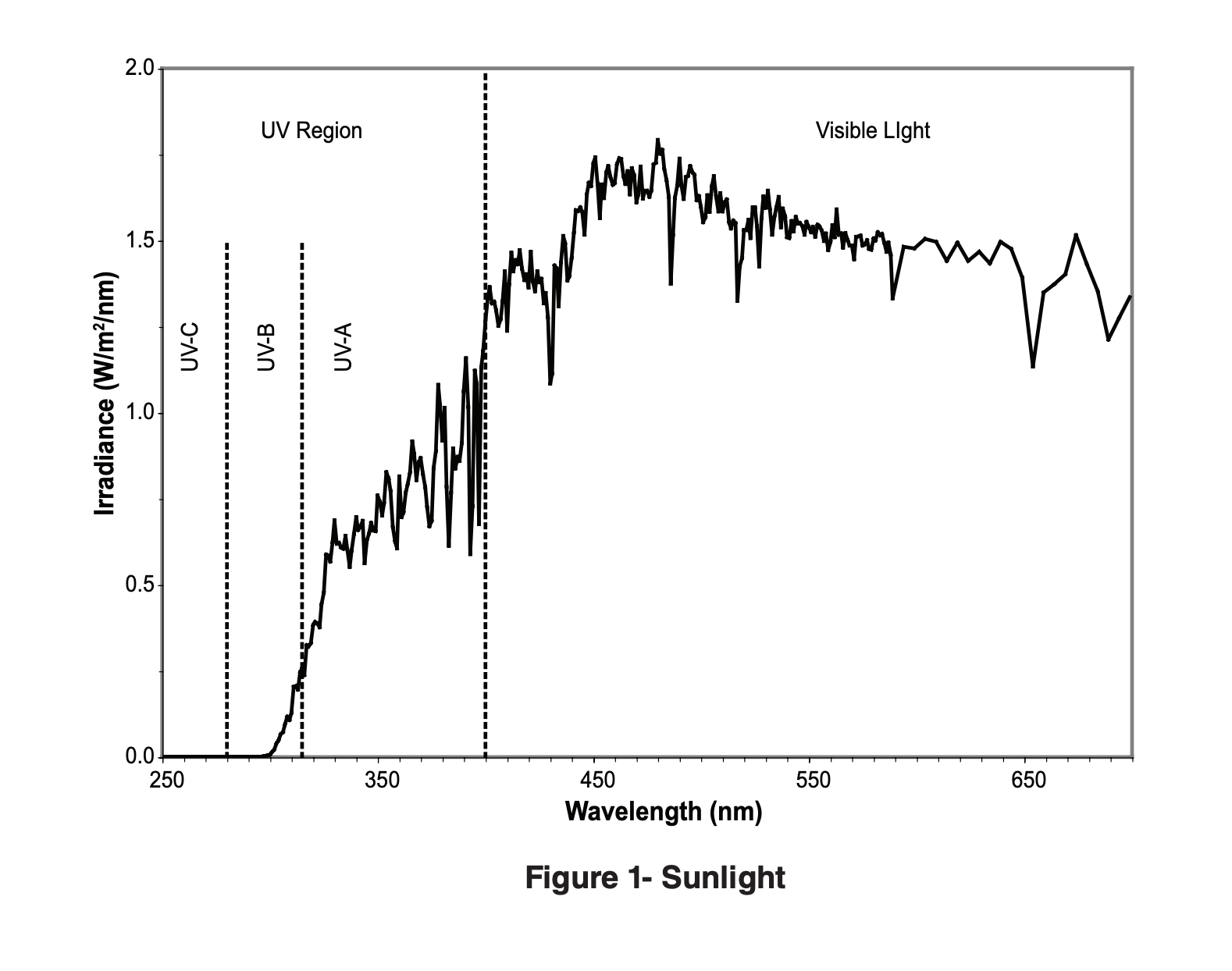
For many manufacturers, it is crucial to formulate products that can withstand light exposure. Accelerated weathering testers are designed to simulate natural sunlight, and are widely used for research and development, quality control and material certification. These testers can provide fast, repeatable and reproducible results. In order to quantify the wide variations in the UV content of sunlight, four categories of spectroradiometric measurements were taken. These include direct summer sunlight, winter sunlight, sunlight filtered though ordinary window glass and sunlight filtered through automotive glass. In order to quantify the spectra from the various lab testers, spectroradiometric measurements were made in various types of accelerated testers including QUV® Accelerated Weathering Testers (i.e., fluorescent UV and condensation testers) and xenon arc chambers. In addition, spectra were calculated for the accelerated outdoor exposure device known as the Q-TRAC® Natural Sunlight Concentrator. The various accelerated devices show a wide variety of spectra. These measurements suggest recommendations for the use of different testers or different light sources for different applications.
The Sunlight Spectrum
The electromagnetic energy from sunlight is normally divided into ultraviolet, visible light and infrared energy, as shown in Figure 1. Ultraviolet light consists of radiation below 400 nanometers (nm). Visible light is defined as radiation between 400 and 760 nm. Infrared energy consists of wavelengths longer than the visible red wavelengths, and starts above about 760 nm. Variability of Sunlight. Because UV is easily filtered by air mass, cloud cover, pollution, etc., the amount and spectrum of natural UV exposure is extremely variable. Sunlight varies from moment to moment throughout the day. Figure 2 shows the spectral power distribution (SPD) of full spectrum sunlight measured at several times throughout the day (where & when).
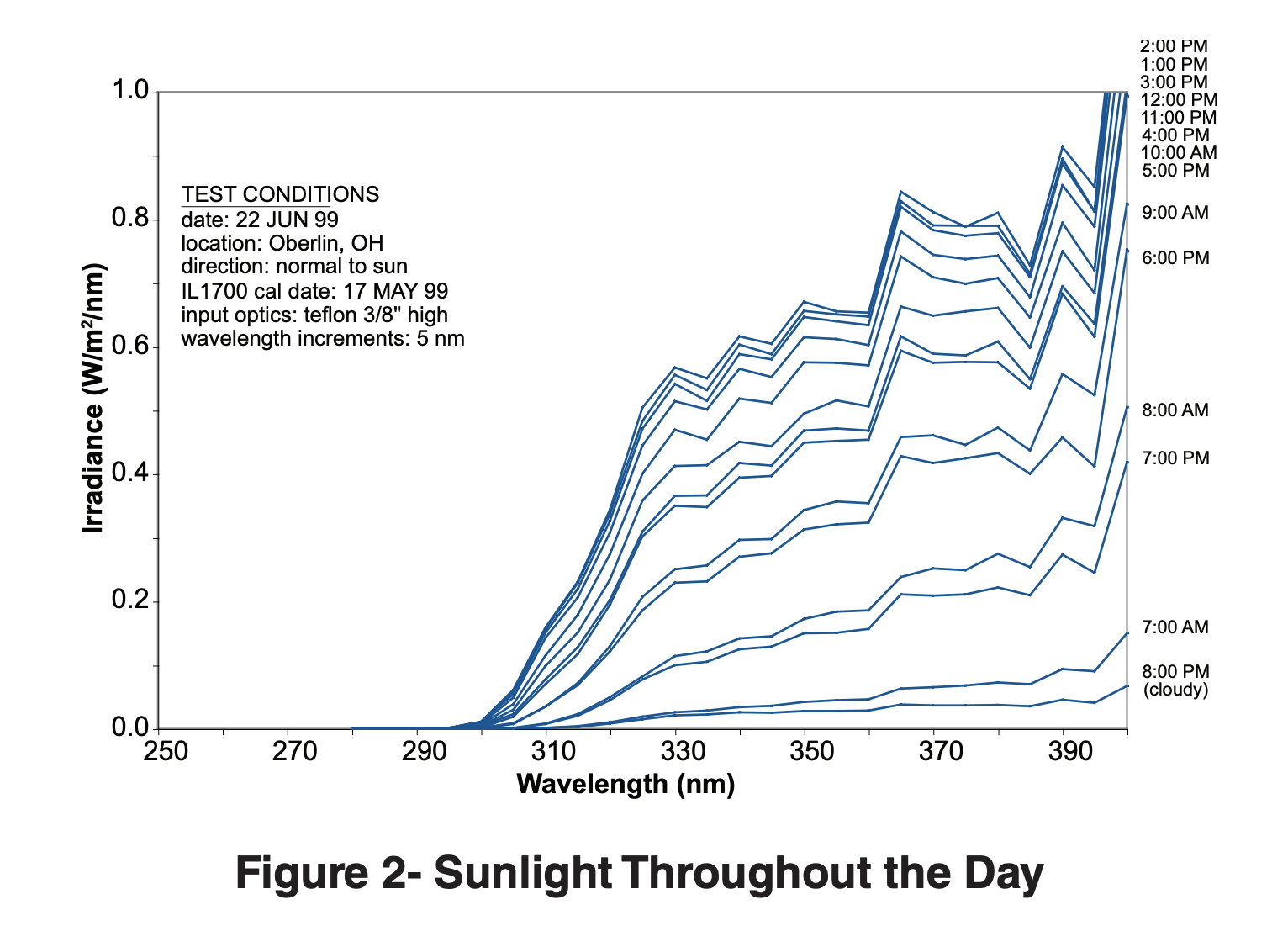
The SPD of sunlight also varies throughout the year. The greatest variability is in the UV region. Figure 3 shows a comparison of the UV regions of sunlight, measured in Cleveland, Ohio, USA at noon on:
- The summer solstice (longest day of the year)
- The winter solstice (shortest day of the year)
- The spring equinox.
These measurements are in agreement with data reported by other investigators. See ASTM G173 for a useful reference spectrum.
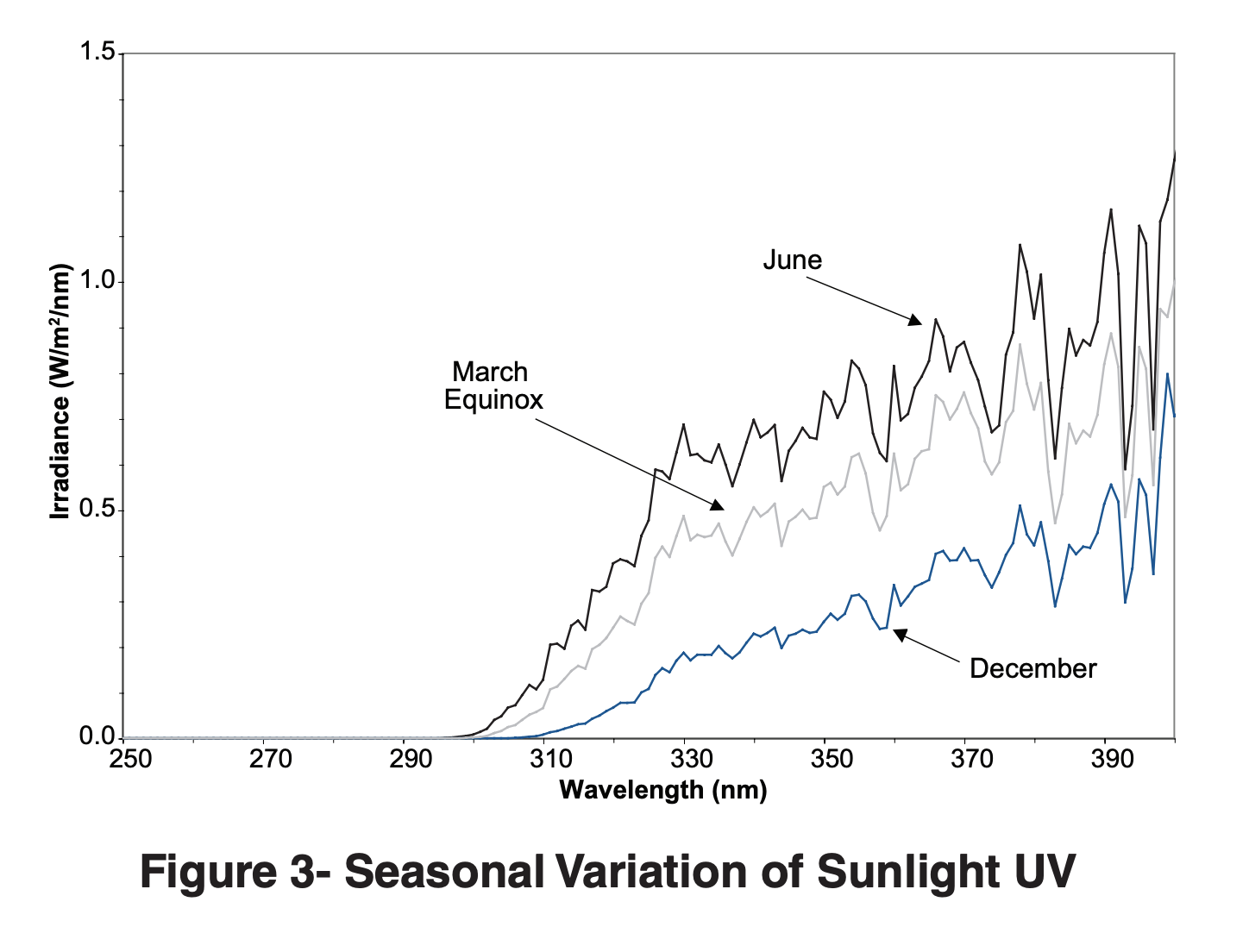
Because the sun is lower in the sky during the winter months, it is filtered through a greater air mass (Figure 4). This introduces two important distinctions between summer and winter sunlight: changes in the intensity of the light and changes in the spectrum. Most importantly, the shorter, more damaging UV wavelengths are filtered out during the winter. For example, the intensity of UV at 320 nm is about 8 times greater in the summer than in the winter. In addition, the short wavelength solar cut-off shifts from about 295 nm in summer to about 310 nm in winter months. Consequently, materials sensitive to UV below 310 nm would degrade only slightly, if at all, during the winter months. These types of changes are especially significant for polymeric materials, such as PVC.

Spectral Sensitivity
The amount and type of damage that a material is susceptible to is dependant upon the spectral sensitivity of that particular material. Spectral sensitivity is a measure of how damage caused by a unit of light energy varies according to the wavelength of light. Spectral sensitivity may vary from material to material, and similar materials formulated for the same application may have significantly different spectral sensitivities. Spectral sensitivity determines whether a material is sensitive to short wavelengths, long wavelengths, or both.
Importance of Short Wavelength Cut-Off. Photochemical reactions are caused by photons of light breaking chemical bonds. For each type of chemical bond, there is a critical threshold wavelength of light that contains enough energy to cause a reaction. Light of any wavelength shorter than this threshold can break the bond, but longer wavelengths of light cannot, regardless of the light’s intensity. Therefore, the short wavelength cut on of a light source is of critical importance. For example, if a particular polymer is only sensitive to UV light below 295 nm (the solar cut-off point), it will never experience photochemical deterioration outdoors. If the same polymer is exposed to a laboratory light source that has a spectral cut-off of 280 nm, it will deteriorate. Consequently, light sources that produce shorter wavelengths produce faster tests, but there is a possibility of anomalous results if a tester has a wavelength cut-off that is too far below that of the material’s end-use environment.
Importance of Longer Wavelengths
For interiorgrade materials, such as inks and dyes, longer wave UV and short wave visible light often have a significant effect. IR radiation can also effect degradation because of the heat buildup. In addition, IR can be responsible for thermal degradation in some materials. And, although IR does not cause photodegradation, the increased temperatures it may create can lead to an increase in the rate of photoinitiated degradation.
Accelerated Light Sources Compared to Sunlight
The following discussion of accelerated light sources will confine itself to the issue of spectrum. It will not address spectral stability, the effects of moisture, the effects of exposure cycles or the reproducibility of results.
To analyze their usefulness for simulating sunlight, the most common laboratory light sources will be compared to what we call the Solar Maximum condition: global, noon sunlight, at normal incidence, on the summer solstice. The Solar Maximum is the most severe condition met in outdoor service, and as such it controls which materials will fail. It is misleading to compare light sources against socalled “average optimum sunlight,” which is simply an average of the much less damaging summer and winter equinox measurements. Another misleading comparison is the “Miami average,” which is simply an average of one year of Miami sunlight. All graphs labeled "sunlight" in this paper refer to the Solar Maximum.
Despite the inherent variability of solar UV, our measurements show surprisingly little variation in the Solar Maximum at different locations. Figure 5 shows the Solar Maximum measured at three widely varied locations.
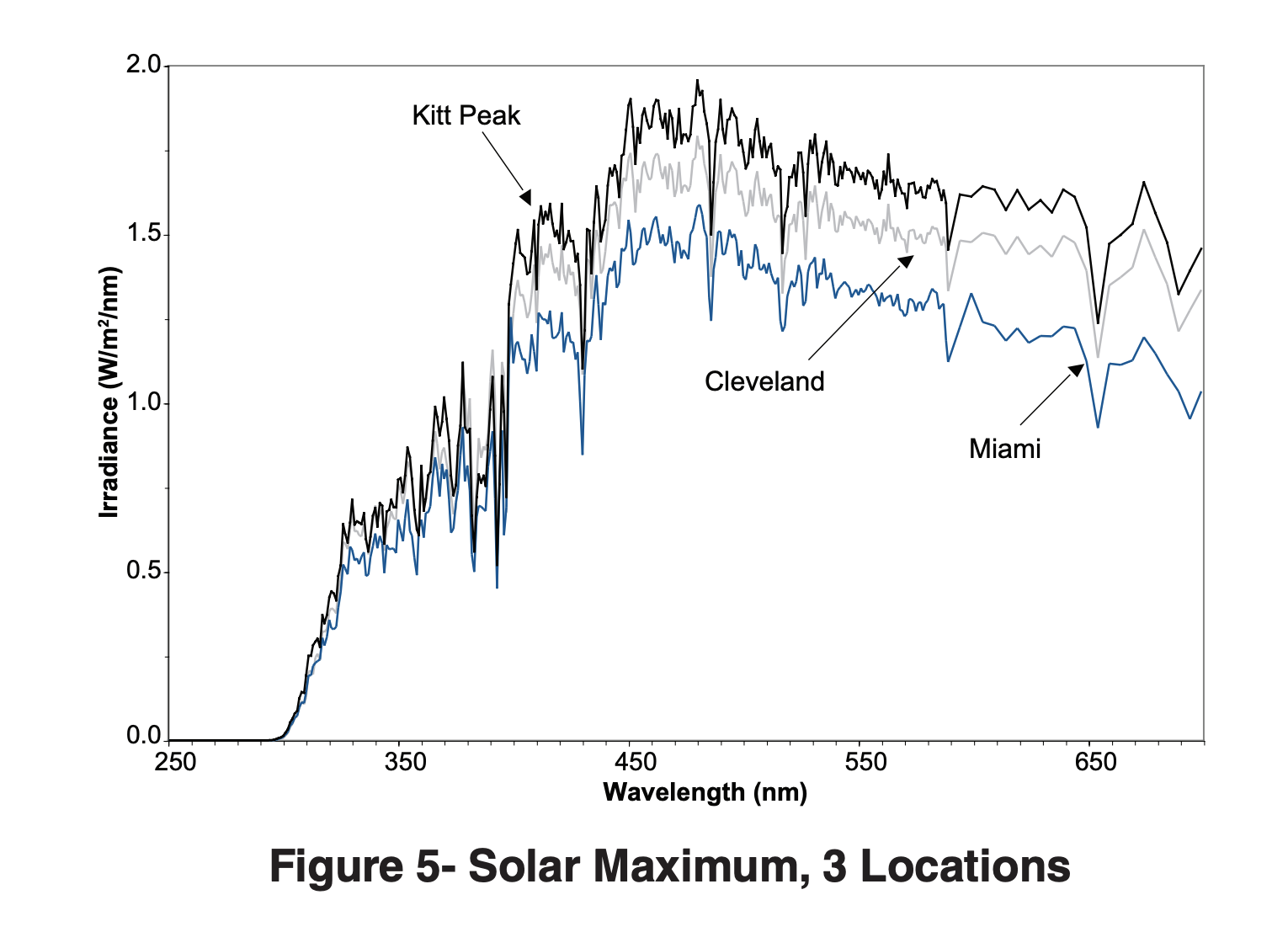
Two Different Approaches
The QUV Accelerated Weathering Tester and the xenon arc are the most commonly used accelerated weathering and light stability testers. These testers are based on two completely different approaches.
Xenon arc testers, such as the Q-SUN ® Xenon Test Chamber, reproduce the entire spectrum of sunlight including ultraviolet (UV), visible light and infrared (IR). The xenon is essentially an attempt to reproduce sunlight itself.
QUV testers do not attempt to reproduce the full spectrum of sunlight, but, rather, just the damag - ing effects of sunlight. This is accomplished by confining the primary emission of their fluorescent lamps to the UV portion of the spectrum. This approach is effective because short wavelength UV causes almost all of the damage to durable materials exposed outdoors. Figure 6 shows the comparison between sunlight, xenon and fluores - cent UV.
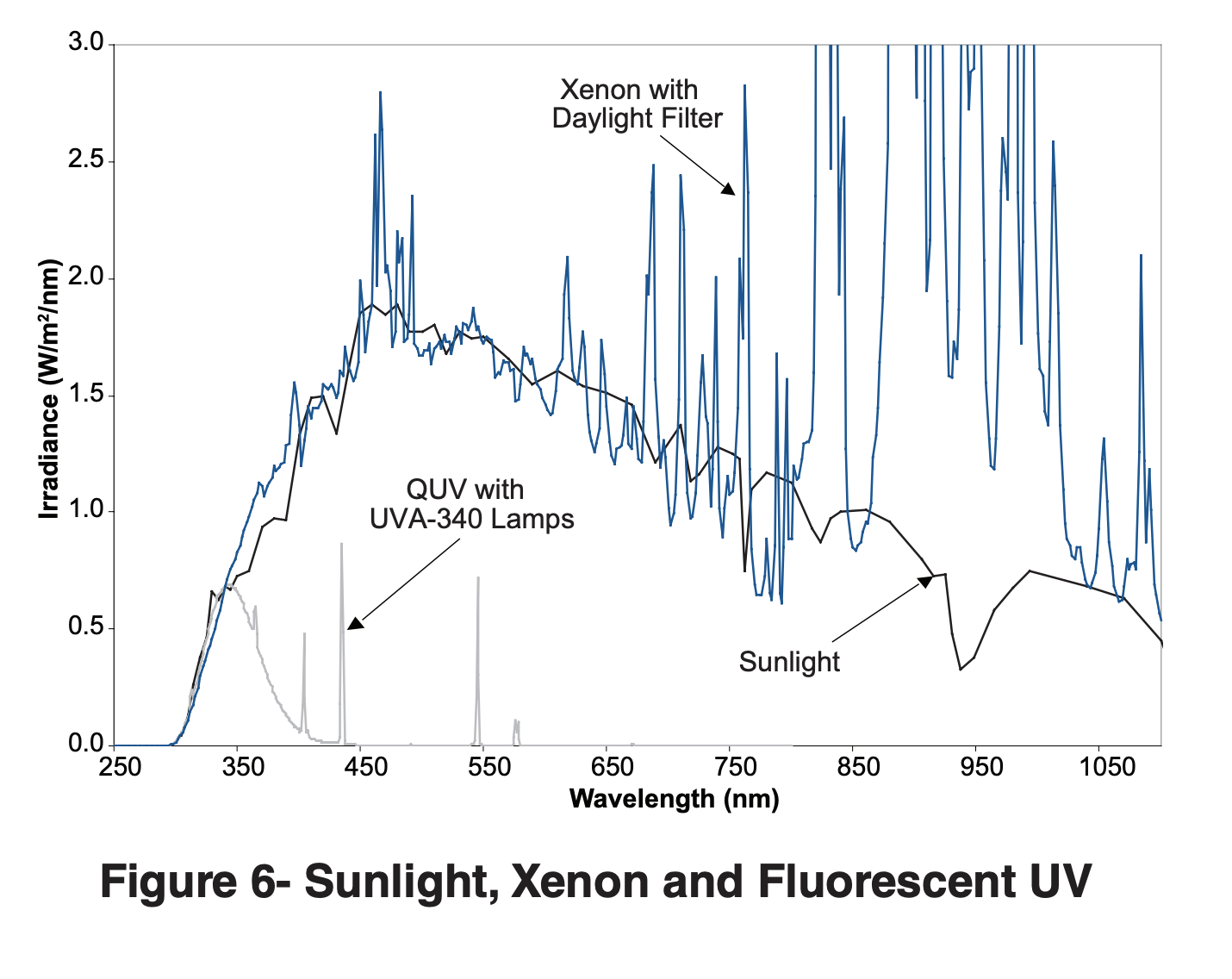
In addition to the technical considerations, there are practical ramifications to these differing ap - proaches. Xenon testers require a lot of electrical input to produce their full spectrum. Consequent - ly, they also generate a lot of heat from the visible and IR portions of the spectrum. This heat must be removed by either a water-cooling or an aircooling system. Therefore, differences in the operating costs of the two tester types are significant. For a full discussion, see Q-Lab Technical Bulletin LU-8009, QUV & Q-SUN: A Comparison of Two Effective Approaches To Accelerated Weathering & Light Stability Testing.
Xenon Arc Lamps
The full spectrum xenon arc (ISO4892-2, ISO11341, ASTM G155, SAE J2412) allows the user to test for damage caused by short-wave UV, as well as longer wavelength dam - age such as fading and color change. There are two main factors to consider when using a xenon tester: effect of filters and irradiance control.
Xenon Filters for Outdoor Simulations
Because the radiation from an unfiltered xenon arc contains too much short-wave UV to allow useful correlation to natural exposures on the earth’s surface, xenon testers employ various types of filters to reduce unwanted radiation and achieve an appropriate spectrum. For most of the filter types used, the greatest effect is on the short wavelength portion of the spectrum. Because the damaging effects of UV are inversely proportional to wavelength, it is critical that the cut-on wave - length match the service environment. The type of filter depends on the materials tested, and the end-use application.
There are three general categories of filters that can be used in a xenon test chamber. Within each general category, there may be several different types of filters. Each filter is a piece of specialty glass designed to have a particular transmission.
Daylight Filters produce spectra approximately equivalent to direct, noon summer sunlight and conform to the spectral requirements of ISO 4892, ISO 11341, ASTM G155, SAE J1960 and SAE J2527. They are recommended for testing materials that are intended for outdoor use and allow the best correlation between xenon and natural outdoor exposures. See Figure 7 and Figure 7A.
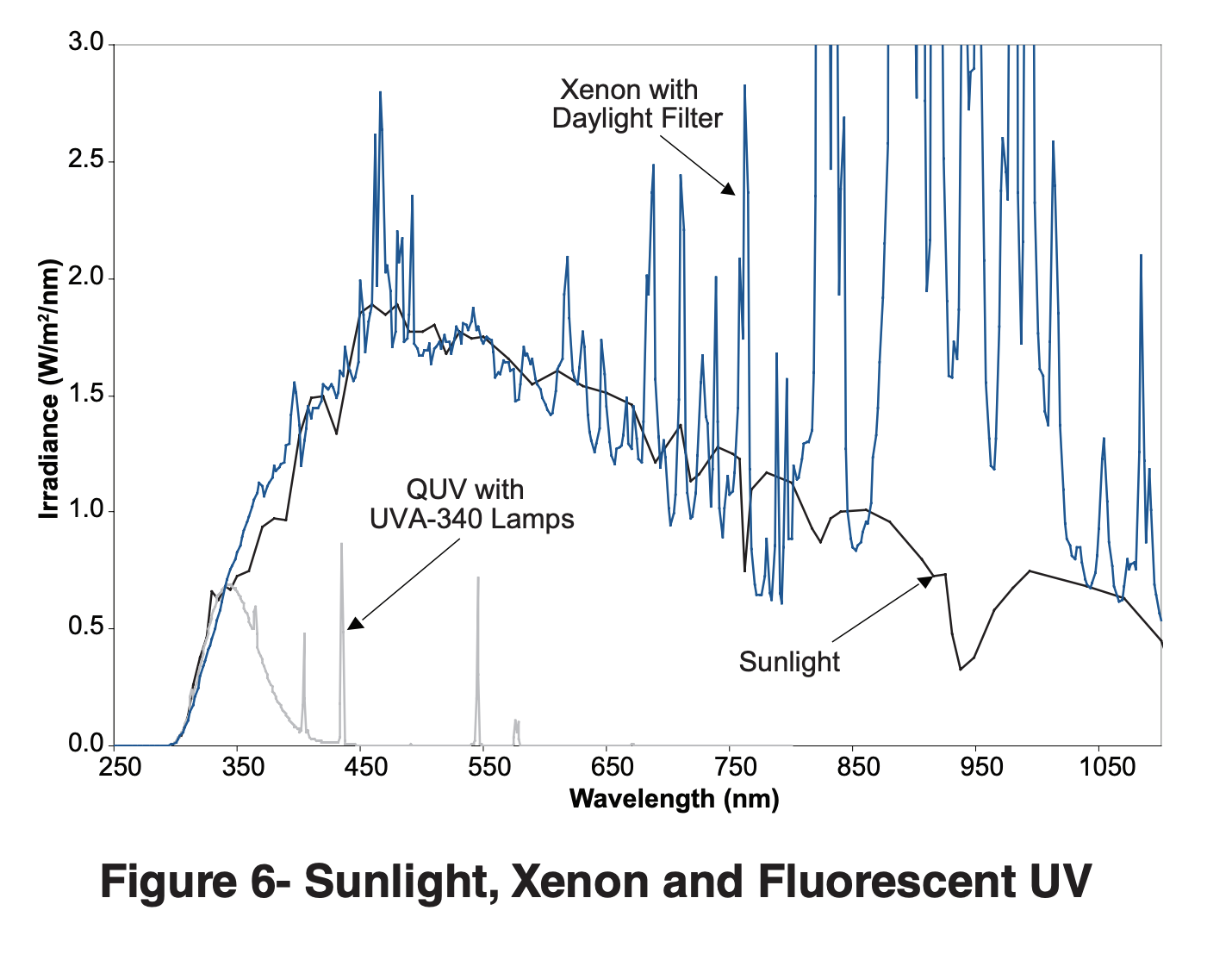
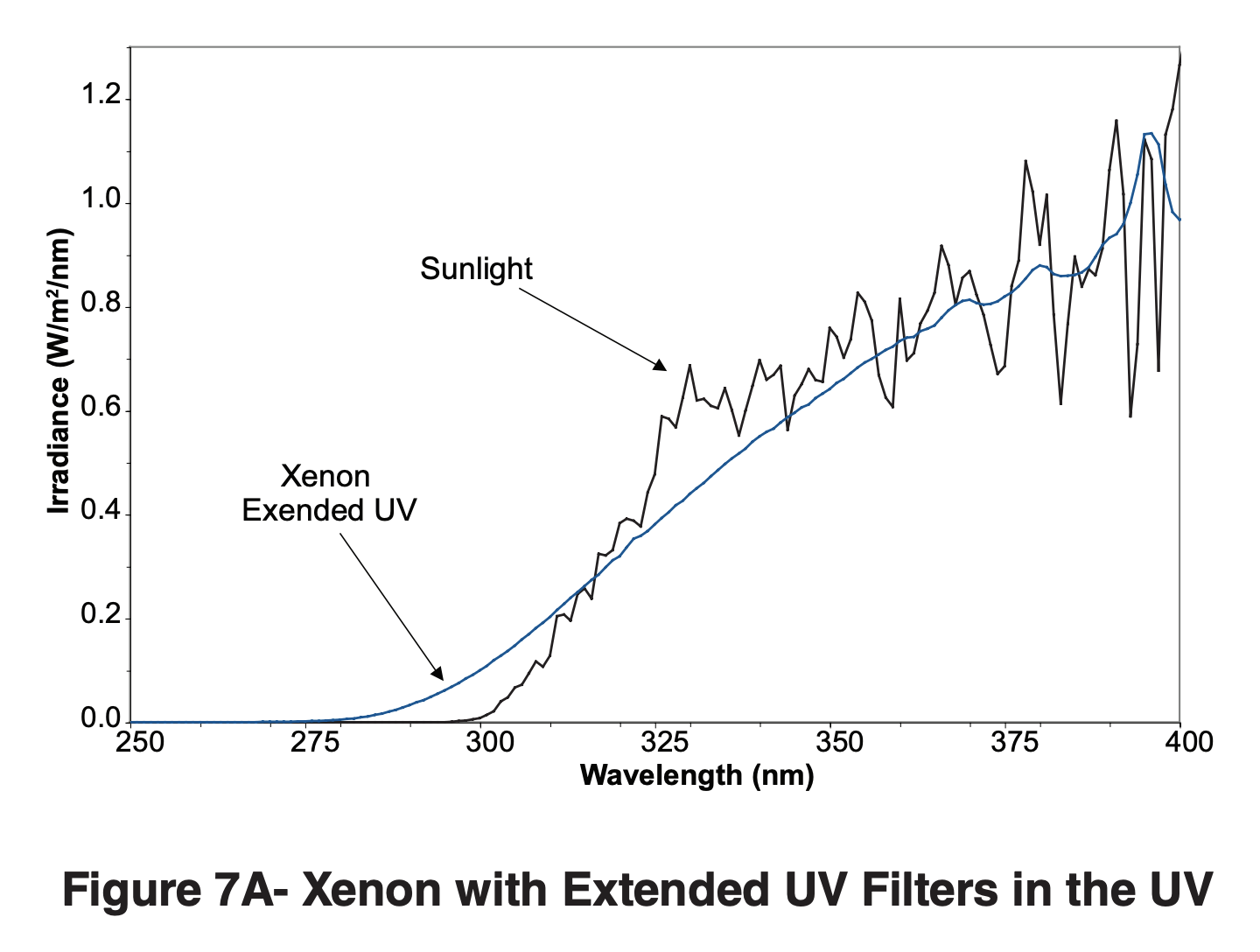
Extended UV Filters allow significant excess UV below the cut-on of natural sunlight at the earth’s surface. Extended UV Filters are often used to produce faster degradation than Daylight Filters. They are required in many automotive test methods. They may also be used to reproduce extraterrestrial spectra for aerospace applications. See Figure 8 and Figure 8A.
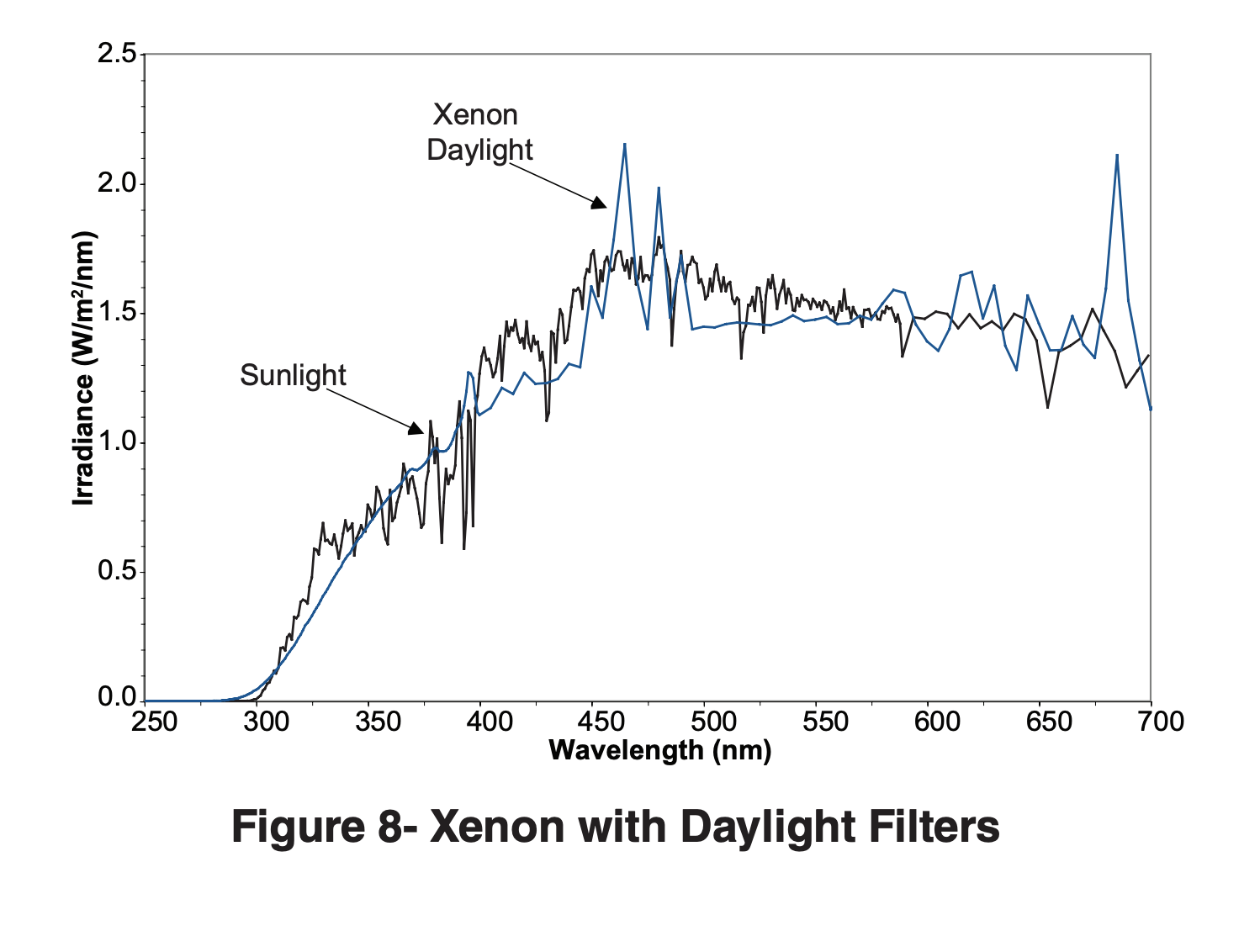

Irradiance Control
To control light intensity, modern xenon arc testers have a light monitoring system to compensate for the inevitable light output decay from lamp aging. The most common irradiance settings are 0.35 or 0.55 W/m2 at 340 nm. Figure 9 shows how these two settings compare to the Solar Maximum. While 0.55 is comparable to summer sunlight, 0.35 is comparable to winter sunlight. However, for historical reasons, 0.35 is the most commonly used setting.
Another irradiance setting that can be used is 0.68 W/m2 at 340 nm. This is the irradiance which is the best match with the Solar Maximum.
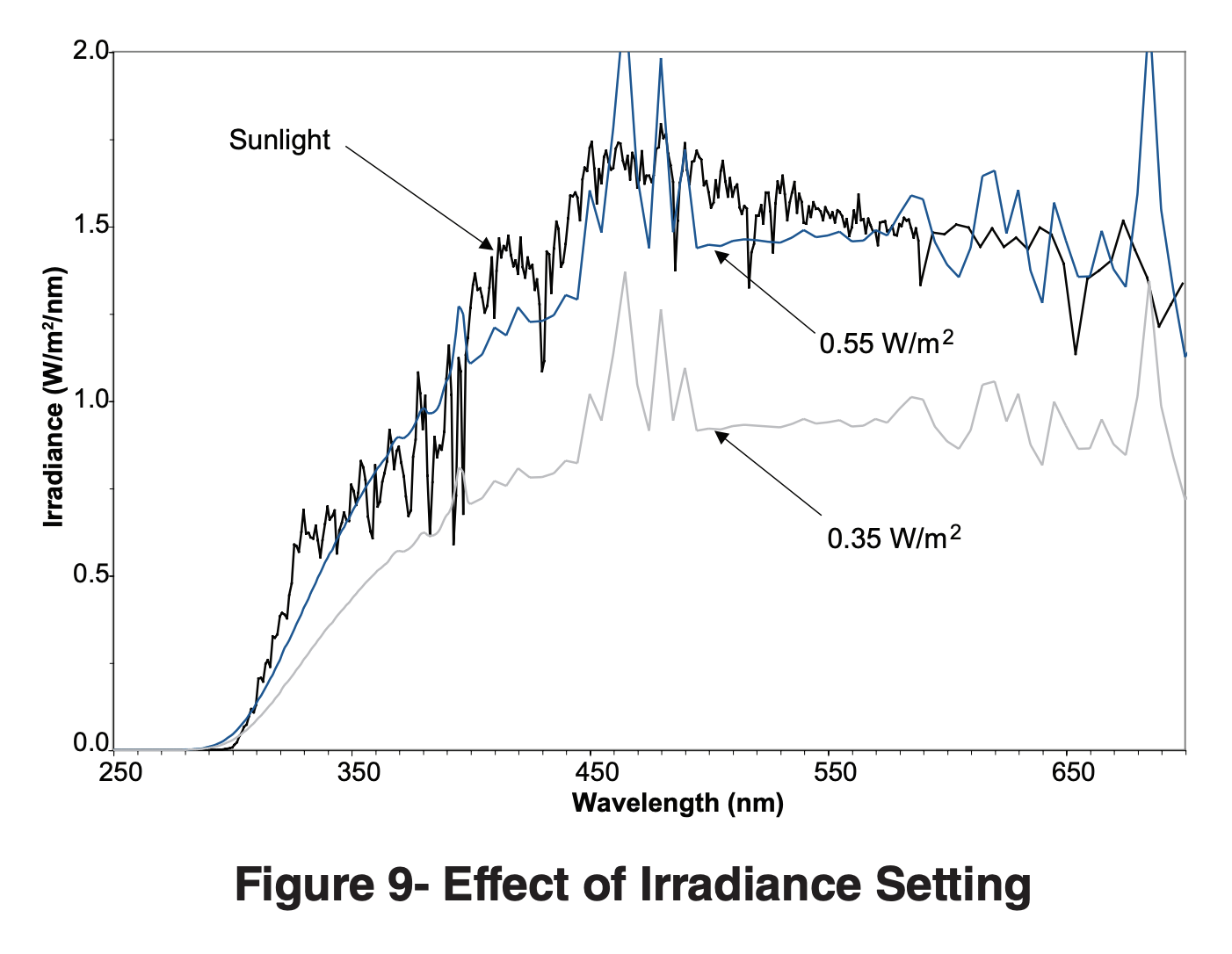
Fluorescent UV
Unlike xenon arcs, QUV testers (ISO4892-3, ISO 11507, ASTM G154, SAE J2020) utilize different types of UV lamps, with different spectra for different exposure applications.
FS-40 Lamps. In the early 1970’s, the FS-40 became the first QUV machine lamp to achieve wide use. This lamp is currently specified in some automotive specifications, particularly for coatings. This lamp has demonstrated good correlation to outdoor exposures for gloss retention on coatings and for the material integrity of plastics. However, the short wavelength output below the solar cut-off can cause anomalous results, especially for color retention of plastics and textile materials.
UVB-313 Lamps were introduced in 1984. The UVB-313 is essentially a second generation FS40. It has the same SPD as the FS-40, but with higher, more stable output. Figure 10 shows the SPD of sunlight compared to the UVB-313 and the FS-40. Because of its higher output, the UVB-313 gives significantly greater acceleration than the FS-40 for most materials. It is especially useful for Quality Control and research applications.
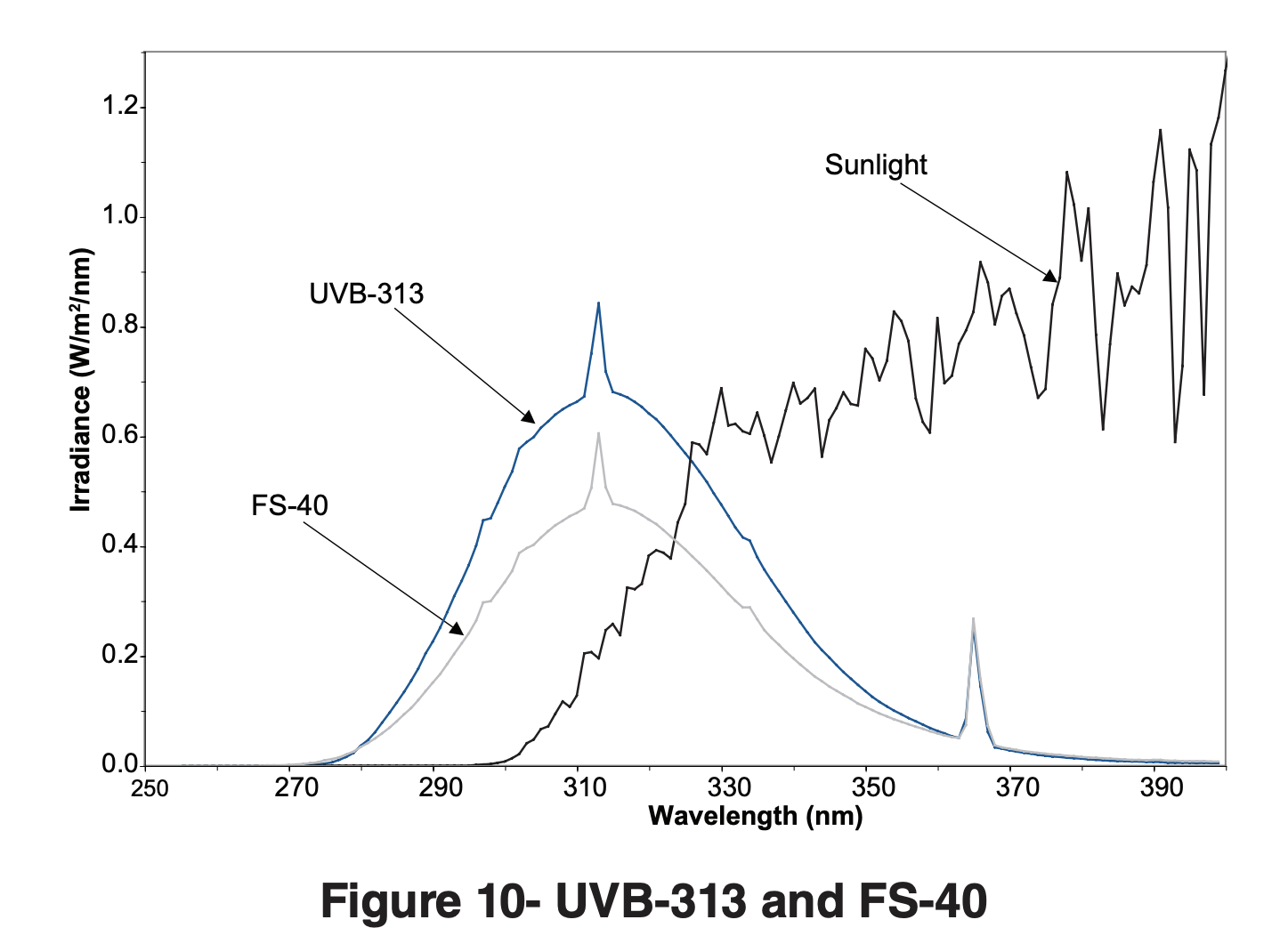
UVA-340 Lamps were designed to enhance correlation with natural exposures. The UVA-340 has been extensively used for both plastics and coat - ings, and greatly improves the correlation possible with QUV testers. Figure 11 shows the UVA-340 compared to the Solar Maximum. This lamp is an excellent simulation of sunlight from about 370 nm to the solar cut-off of 295 nm.
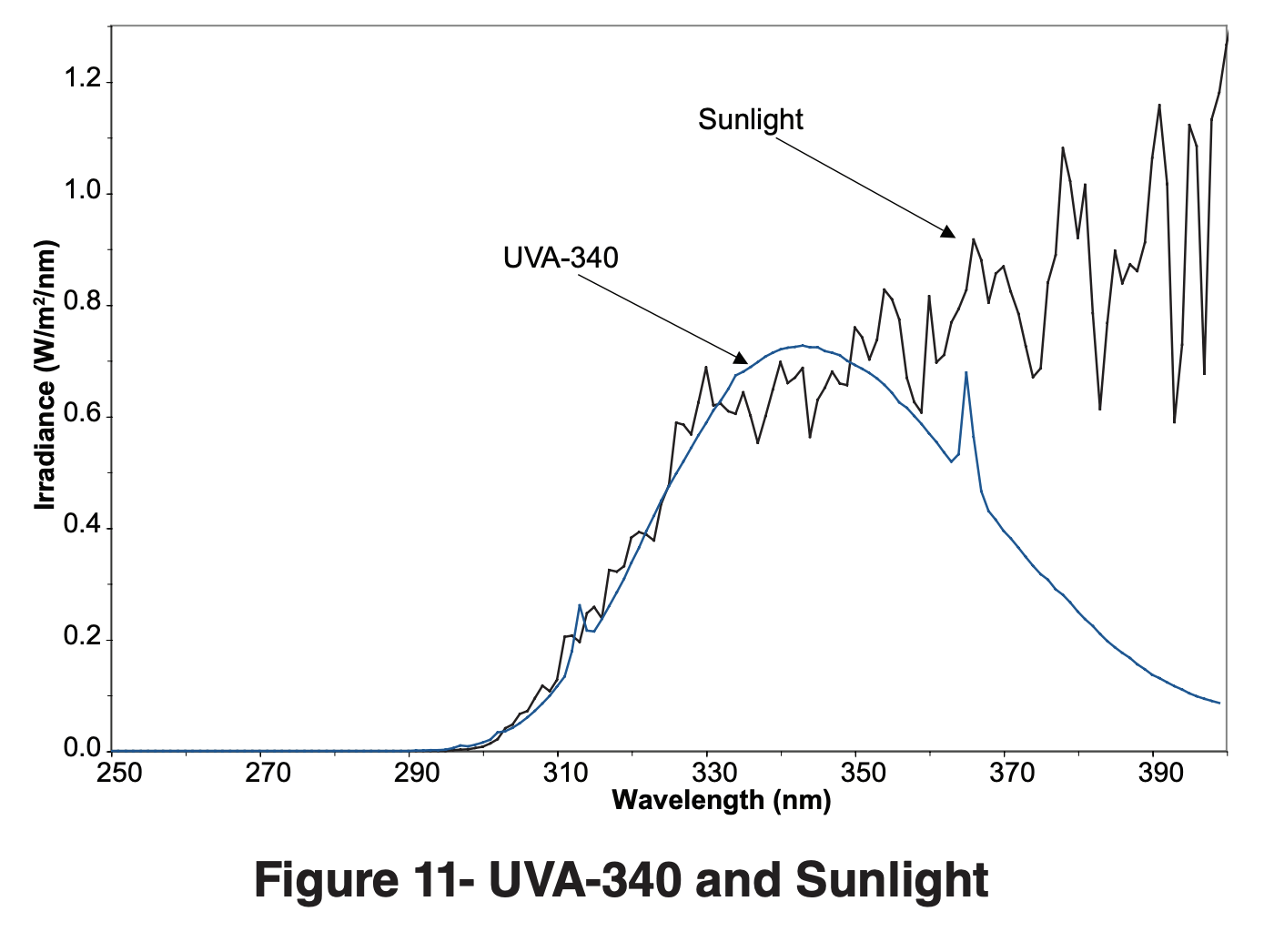
Q-TRAC Natural Sunlight Concentrator. Accelerated outdoor weathering devices that use natural sunlight as their light source have been used for many decades. Simple, early versions were designed to follow the sun from morning until night in order to maximize the amount of sunlight that an outdoor exposure specimen could receive. Later, mirrors were added to concentrate the sunlight onto the test specimens for even greater acceleration. This solar concentrating accelera - tion technique has been standardized in ISO 877, ASTM G90 and SAE J1961, among others.
The Q-TRAC and other sunlight concentrators use a series of 10 mirrors to reflect full spectrum sunlight. The spectrum that the test specimens actually receive is affected by the fact that the de - vice utilizes only direct beam sunlight and that the reflectivity of the mirrors is not perfectly efficient. Figure 12 shows a comparison of natural sunlight and the Q-TRAC concentrator spectrum.
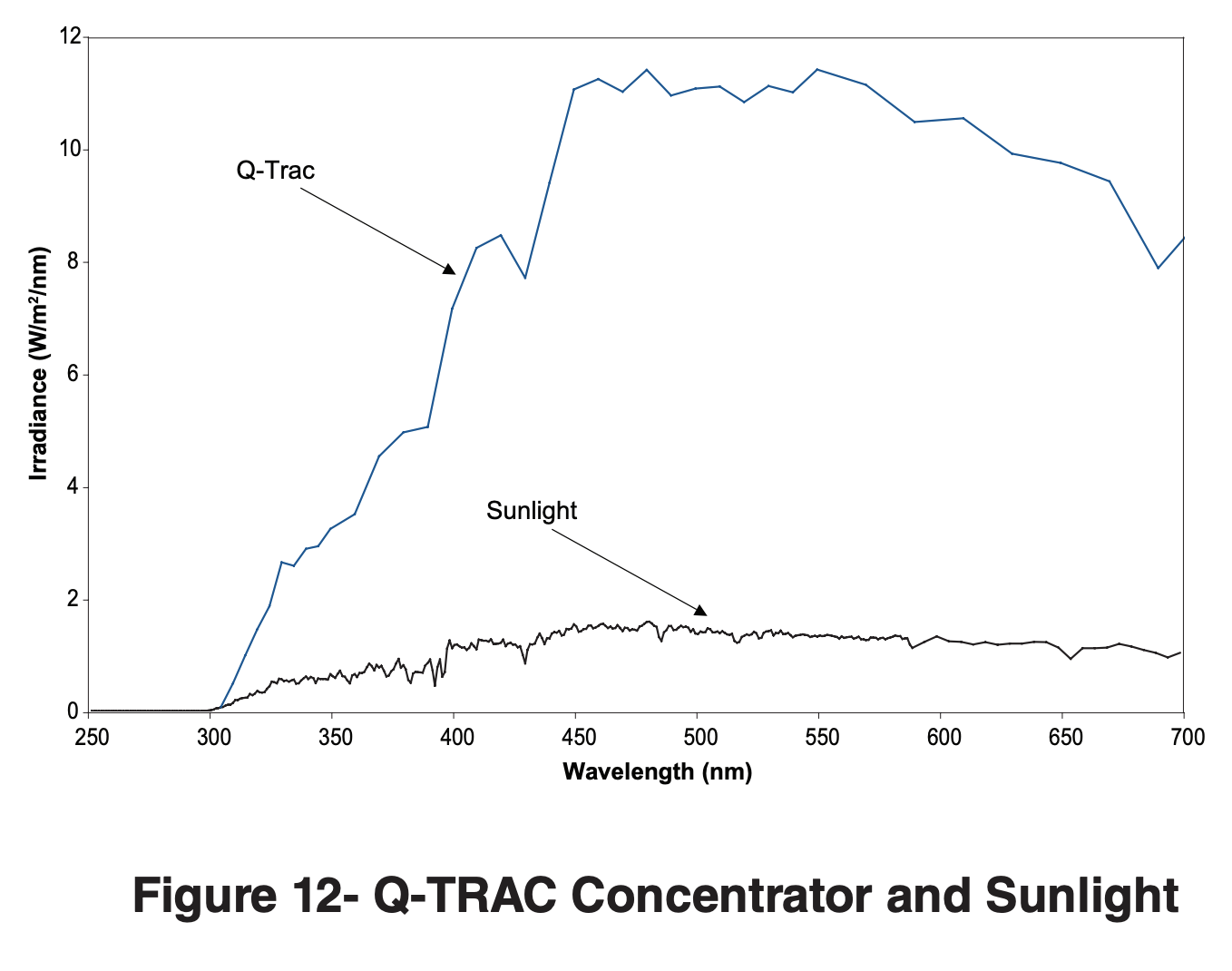
Filtering Effect of Glass on Sunlight
Common Window Glass. Glass of any type acts as a filter on the sunlight spectrum. The shorter, more damaging wavelengths are the most greatly affected. Figure 13 shows direct sunlight compared to sunlight filtered though ordinary, single-strength, untinted, 0.125 inch thick window glass. Ordinary glass is essentially transparent to light above 370 nm. However, the filtering effect becomes more pronounced with decreasing wave - lengths. In fact, the most damaging wavelengths below about 310 nm are completely filtered out.
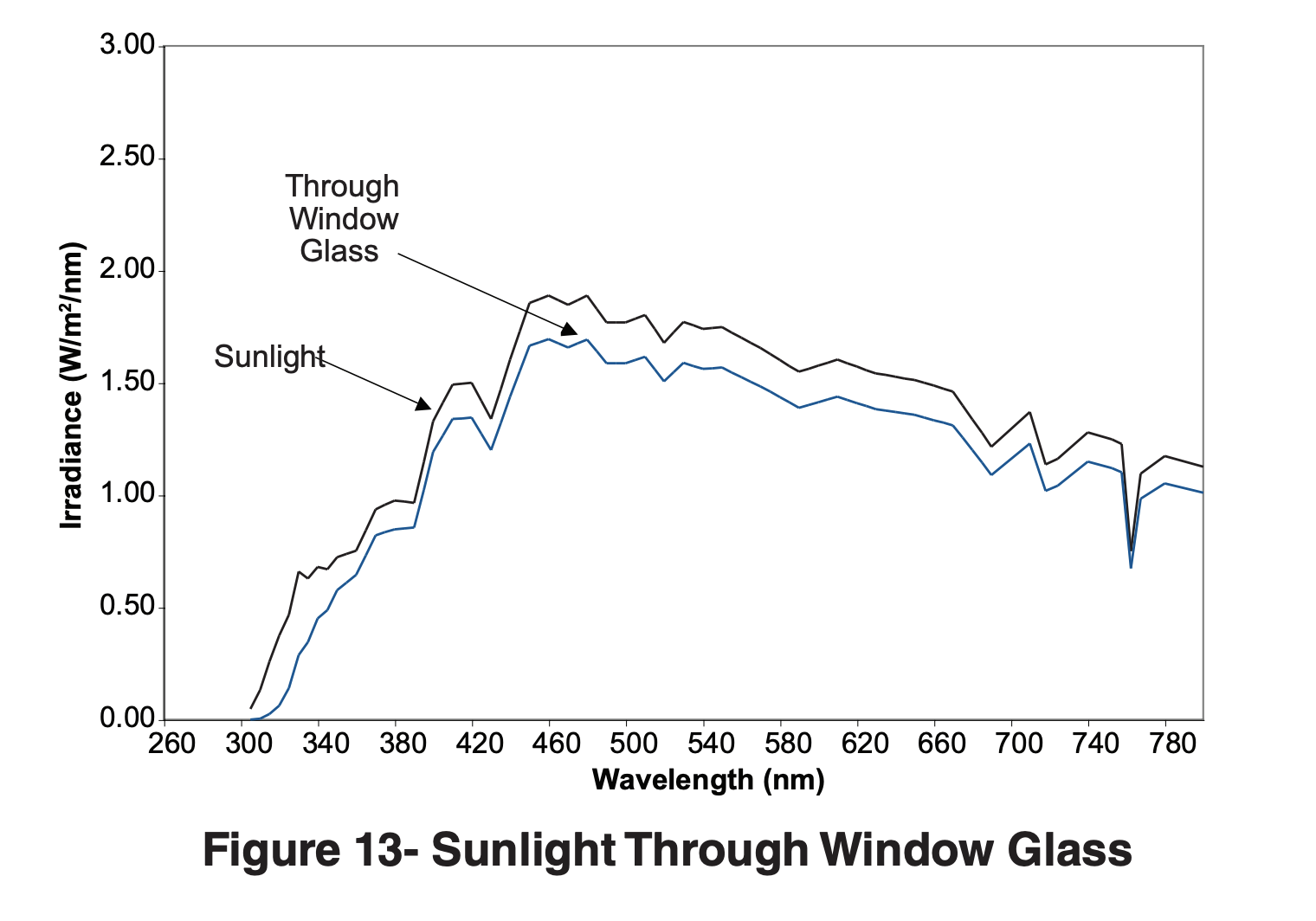
Automotive Glass. Automotive glass is thicker than window glass. It is frequently tinted and windshield glass normally contains a layer of lami - nated plastic. Figure 14 shows a comparison of direct sunlight with sunlight through window glass and sunlight through windshield glass. All of these act to improve the filtering efficiency of auto glass and almost all of the most damaging UV is filtered out. Figure 15 shows the SPD of four different types of automotive glass, with varying thickness and tint combinations.

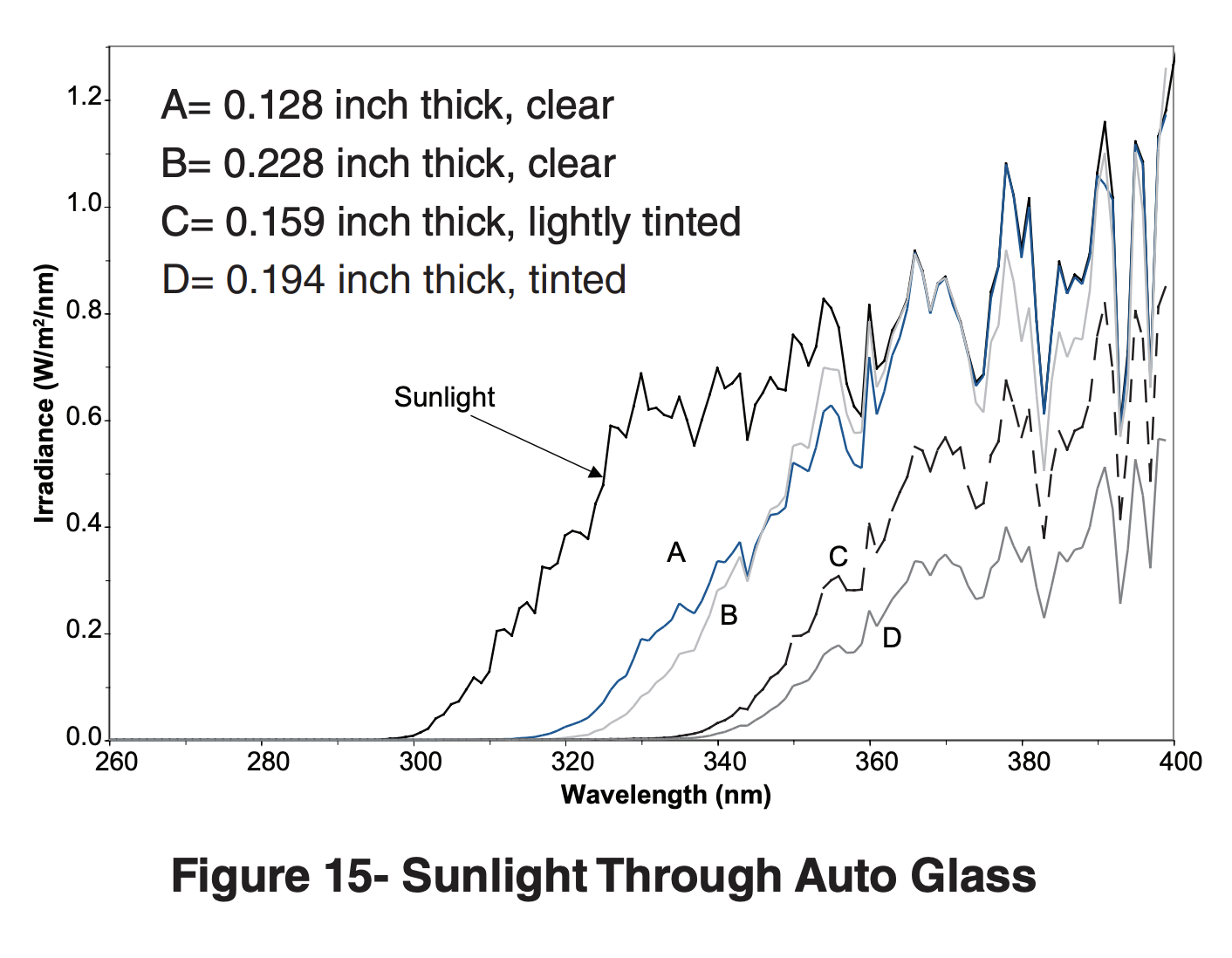
Accelerated Light Sources and Sunlight Through Glass
Xenon Arc. Properly filtered xenon arc (ISO 4892-2, ISO 105 B02, ASTM G-155, SAE J2527, AATCC TM16-3) provides the best simulation of sunlight through window glass. However there is no single “standard window glass.” Because transmission varies due to thickness, chemical composition, etc., several Window Glass Filters have been developed for the Q-SUN Xenon Test Chamber.

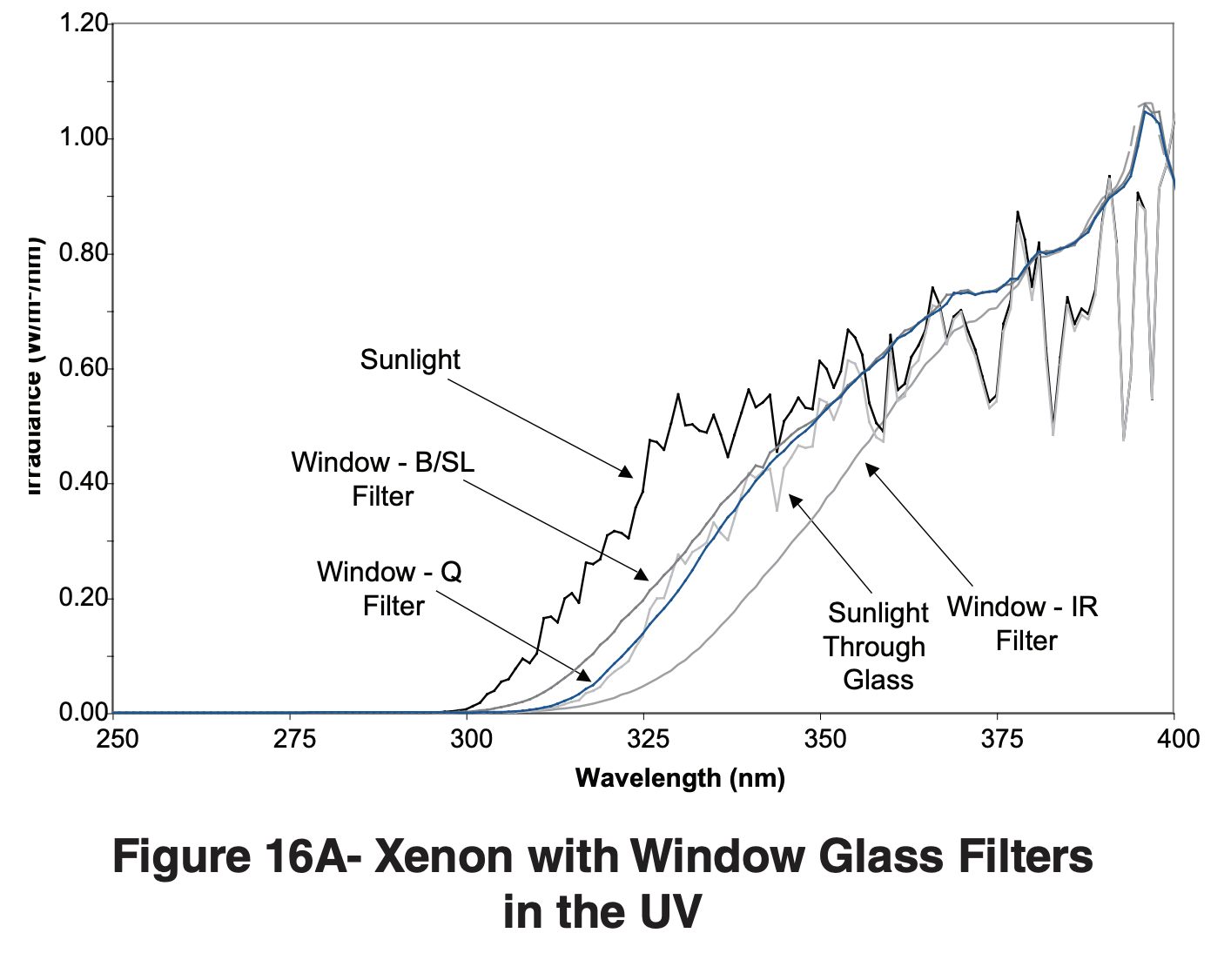
The spectra produced by xenon test chambers using Window Glass Filters also covers most of the wavelengths that would be found from the many artificial light sources used indoors (cool white fluorescent, etc.), so it is also appropriate for most indoor applications. See Figure 17.

Note: Some automotive test methods for interior materials like textiles and soft trim still specify the extended UV Filter. SAE J1885 and SAE J2412 are examples of this. Figure 18 shows this xenon method compared to sunlight through ordinary glass. Obviously an excessive amount of short wave UV is allowed by the Extended UV Filter and the correlation to real world results should be examined carefully.
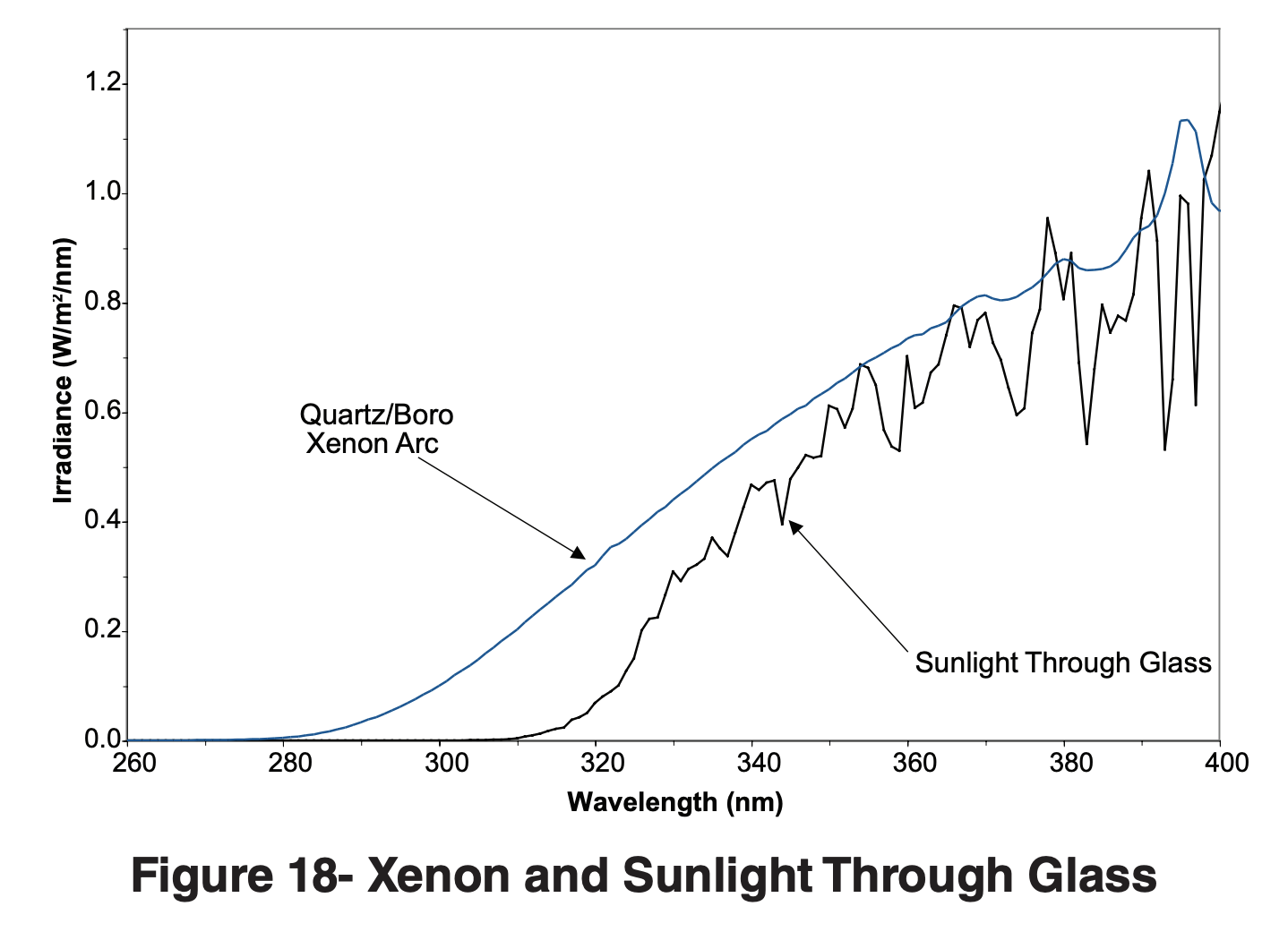
Conclusions and Caveats
Correlation between laboratory and natural exposure test results will probably always be controversial. The user must educate himself to make a number of choices.
Because there are several types of lab testers with multiple lamps and filters available, no single tester is perfect for every application. Short wave UV is usually best for testing polymer degradation, while the full spectrum approach is often most appropriate for testing for color change of pigments and dyes. Light sources that produce very short wavelength UV give fast results, but they may not always be accurate. Usually when they are wrong, they are wrong on the safe side in that the results are too severe.
Light sources that eliminate wavelengths below the solar cut-off of 295 nm will give more accurate results, but the price for increased correlation is usually reduced acceleration. As Fischer has shown, test speed and accuracy are inversely related.
In addition, we should point out that despite the current interest in light energy, the spectrum of a test device is only one piece of the puzzle. With any accelerated tester, there are a number of parameters that can be programmed: spectrum, moisture, humidity, temperature and test cycle. Furthermore, the parameters that one chooses are, to a certain extent, arbitrary. No single test cycle or device can reproduce all of the variables found outdoors in different climates, altitudes and latitudes. Consequently, even the most elaborate tester is really just a screening device. The real usefulness of accelerated testers is that they can give reliable, relative indications of which materials perform best under a specific set of conditions.
Acknowledgements
The authors are responsible for the accuracy of this paper. However we would like to recognize the assistance of:
- Kit Peak National Observatory
- Ohio Spectrographic Service
- 3M Company
- BASF Corporation
- Americhem Corporation
Reference Note This paper was originally presented at the Society of Plastics Engineers Automotive RETEC in 1987, and published as the Q-PANEL® technical bulletin Sunlight, UV and Accelerated Weathering in 1994. The paper was revised in 2007 and rereleased as Sunlight, Weathering and Light Stability Testing.